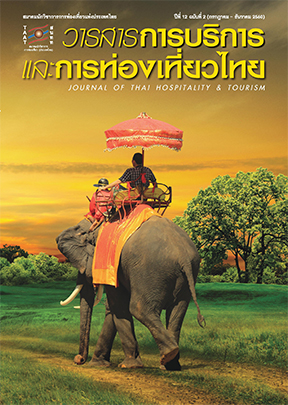ยุทธศาสตร์การพัฒนาศักยภาพการท่องเที่ยวเชิงวัฒนธรรมจังหวัดศรีสะเกษ
Main Article Content
บทคัดย่อ
การวิจัยครั้งนี้มีวัตถุประสงค์เพื่อพัฒนาและประเมินยุทธศาสตร์การพัฒนาศักยภาพการท่องเที่ยวเชิงวัฒนธรรมของจังหวัดศรีสะเกษ กลุ่มตัวอย่างที่ใช้ในการศึกษา ได้แก่ ประชากรที่อาศัยอยู่ในแหล่งท่องเที่ยวทางวัฒนธรรมจังหวัดศรีสะเกษ จำนวน 245 คน กลุ่มเป้าหมายที่ใช้ในการศึกษา ได้แก่ ผู้มีความรู้และประสบการณ์ด้านการท่องเที่ยวจำนวน 74 คน และผู้เชี่ยวชาญ จำนวน 24 คน เครื่องมือที่ใช้ในการวิจัย ได้แก่ แบบสำรวจศักยภาพการท่องเที่ยวเชิงวัฒนธรรม แบบบันทึกการสนทนากลุ่ม แบบประเมินความพึงพอใจในการจัดตั้งศูนย์กลางการเรียนรู้ทางวัฒนธรรมของจังหวัดศรีสะเกษ และแบบประเมินความเหมาะสมและความเป็นไปได้ของยุทธศาสตร์ สถิติที่ใช้ในการวิเคราะห์ข้อมูลเชิงปริมาณ ได้แก่ ร้อยละ ค่าเฉลี่ยและส่วนเบี่ยงเบนมาตรฐาน และการวิเคราะห์ข้อมูลเชิงคุณภาพใช้การวิเคราะห์เชิงเนื้อหา
ผลการวิจัยพบว่า ยุทธศาสตร์การพัฒนาศักยภาพการท่องเที่ยวเชิงวัฒนธรรมของจังหวัดศรีสะเกษ มี 5 ยุทธศาสตร์ 25 กลยุทธ์ 90 มาตรการ 86 ตัวชี้วัด ได้แก่ ยุทธศาสตร์ที่ 1 การผลักดันจังหวัดศรีสะเกษเป็นศูนย์กลางความหลากหลายของการท่องเที่ยวเชิงวัฒนธรรมเขตอีสานใต้ มีกลยุทธ์ที่สำคัญคือ ผลักดันการท่องเที่ยวเชิงวัฒนธรรมของจังหวัดศรีสะเกษเป็นวาระของพื้นที่อีสานใต้ ส่งเสริมและพัฒนาการบริหารจัดการการท่องเที่ยวเชิงวัฒนธรรมอย่างเป็นระบบ ยุทธศาสตร์ที่ 2 การยกระดับการท่องเที่ยวเชิงวัฒนธรรมของจังหวัดศรีสะเกษสู่เศรษฐกิจสร้างสรรค์เพื่อเพิ่มมูลค่าให้ชุมชน มีกลยุทธ์ที่สำคัญคือ ส่งเสริมการใช้ประโยชน์จากองค์ความรู้ทางวัฒนธรรมมาเพิ่มมูลค่าทางเศรษฐกิจ สร้างตราสินค้าการท่องเที่ยวเชิงวัฒนธรรม ยุทธศาสตร์ที่ 3 การพัฒนาปัจจัยสนับสนุนทางการท่องเที่ยวเชิงวัฒนธรรมของจังหวัดศรีสะเกษ มีกลยุทธ์ที่สำคัญคือ จัดทำแผนพัฒนาโครงสร้างพื้นฐาน ระบบโลจิสติกส์ มาตรการและสิ่งอำนวยความสะดวกในแหล่งท่องเที่ยวเชิงวัฒนธรรมให้เป็นมาตรฐานสากล เร่งรัดการดำเนินงานพัฒนาโครงสร้างพื้นฐานและสิ่งอำนวยความสะดวกด้านการท่องเที่ยว ยุทธศาสตร์ที่ 4 การสร้างปัจจัยทางการท่องเที่ยวที่เอื้อต่อการแข่งขันเพื่อส่งเสริมกิจกรรมการท่องเที่ยวเชิงวัฒนธรรมของจังหวัดศรีสะเกษ มีกลยุทธ์ที่สำคัญคือ ส่งเสริมและสนับสนุนการสร้างความโดดเด่น การสร้างเรื่องราวที่สะท้อนความเป็นตัวตนของแหล่งโบราณสถานแต่ละอำเภอ และส่งเสริมพัฒนากิจกรรมสร้างสรรค์ที่แปลกใหม่นำเสนอแหล่งท่องเที่ยวและกิจกรรมด้านประเพณีวิถีชีวิต และยุทธศาสตร์ที่ 5 ส่งเสริมการมีส่วนร่วมของภาครัฐ เอกชน ชุมชนและเครือข่ายในการพัฒนาศักยภาพการท่องเที่ยวเชิงวัฒนธรรมบนฐานของทุนทางสังคมวัฒนธรรม มีกลยุทธ์ที่สำคัญ คือ สร้างความเข้าใจและความตระหนักให้ชุมชนเห็นความสำคัญของทุนทางวัฒนธรรมที่มีอยู่และพัฒนาสู่ความยั่งยืน สร้างเครือข่ายเฝ้าระวังผลกระทบของการจัดการท่องเที่ยวเชิงวัฒนธรรม ผลการประเมินความเหมาะสมและความเป็นไปได้ของยุทธศาสตร์พบว่า โดยภาพรวมมีความเหมาะสมในระดับมากที่สุดและความเป็นไปได้ในระดับมาก
Article Details
เอกสารอ้างอิง
[2] Boonyathitan, Ekachai. (2010). SWOT Analysis, Professional Guide. Bangkok: Punyachon.
[3] Buakwan, Narawadee., Visuthisamajarn. Parichart., & Viriyakorn, Amporn. (2008). Cultural Tourism Guidelines in Klonghae Floating Market, Thailand. International Journal of Management & Information System-Third Quarter, 17(3), 163–168.
[4] Department of Tourism, Ministry of Tourism and Sports. (2009). Guidelines for Assessing the Quality of Tourism for Fiscal Year 2009. Bangkok: Ministry of Tourism and Sports.
[5] Department of Tourism, Ministry of Tourism and Sports. (2011). The ASEAN Tourism Strategic Plan 2011-2015. Bangkok: ASEAN Secretariat.
[6] Department of Tourism, Ministry of Tourism and Sports. (2015). The Arena Tour in December 2014. Bangkok: Ministry of Tourism and Sports.
[7] Division Marketing Strategy Tourism Authority of Thailand. (2014). Direction of the Travel Market, TAT Year 2014. Journal of the Tourism Authority of Thailand. (October-December 2014), 1-4.
[8] Division of ASEAN. (2014). ASEAN (ASEAN Economic Community-AEC). ASEAN Highlight Journal, 46-49.
[9] Hongpakdee, Seubpong. (2013). The Survey of Traditional Communities that are Significance in Culture in Ubon Ratchathani Province for the Creation of Alternative Tourism. Journal of Cultural Approach, 14(26), 32-43.
[10] Malyaporn, Kasama. (2013). World Cultural Heritage in ASEAN: the Exchange of Cultural Heritage. Cross-Culture Exchange. TAT Tourism Journal, 3(July-September 2013), 64-71.
[11] Mettkarunjit, Mett. (2013). Development Strategy: From Theory to Practice Proactive. Nonthaburi: BooksPoint.
[12] Ministry of Culture. (2007). National Master Plan (2007-2016 AD). Bangkok: Strategist Ministry of Culture.
[13] Office of the National Economics and Social Development Board, The Prime Minister Office. (2011). The 11th of the National Economic and Social Development Plan (2012-2016). Bangkok: Sahamit Printing Publishing.
[14] Phagaphasvivat, Somchai. (2008). Strategic Business Competition. Bangkok: Matichon.
[15] Phibulsongkram, Pradap. (2014). Create Linkages in the Region for the Benefit of the People of Thailand. ASEAN Highlight Journal, 50-53.
[16] Pinkeaw, Krailuek. and others (2014). The Development Plan of Culture Tourism Policy for Ayudhya, Pathumthani and Nonthaburi. Bangkok: The Thailand Research Fund (TRF).
[17] Pirasan, Jirawat. and others. (2013). The Development of Tourist Destinations for Cultural Participation of the Community in Phitsanulok. Bangkok: The Thailand Research Fund (TRF).
[18] Rungviseat, Thitaporn. (2007). Development of the Tourism Management Khmer Civilization at the South East to Angkor Wat, Cambodia. Bangkok: The Thailand Research Fund (TRF).
[19] Thammajaree, Kalayanee. (2013). Lecture Tour the Province, in the Development of Tourism Potential. Office of Tourism and Sports, 1st offense on July 1, 2013, at Prompiman Hotel Sisaket Province, 1-25.
[20] Tourism Council of Thailand. (2013). The Business Confidence Index in Thailand. Bangkok: Ministry of Industry.
Tourism Sport and Recreation Centre Sisaket Province. (2011). Tourism Strategy of Sisaket. Sisaket: Office of Tourism and Sports.
[21] World Economic Forum. (2012). The ASEAN Travel & Tourism Competitiveness Report 2012. Published by World Economic Forum, Geneva.


